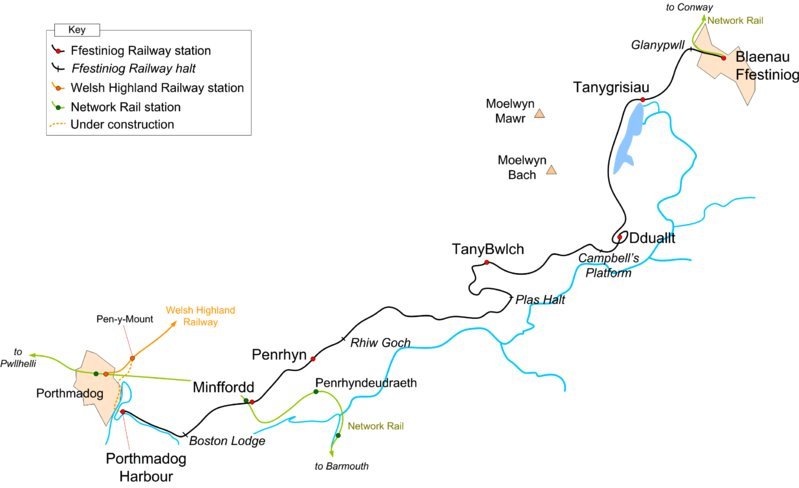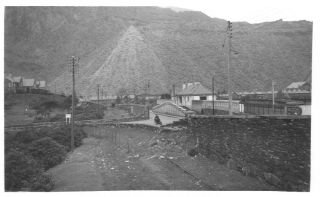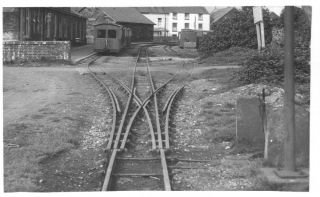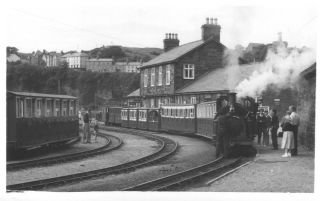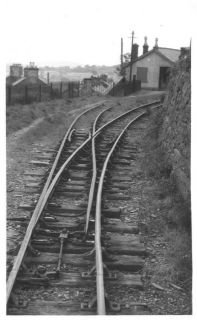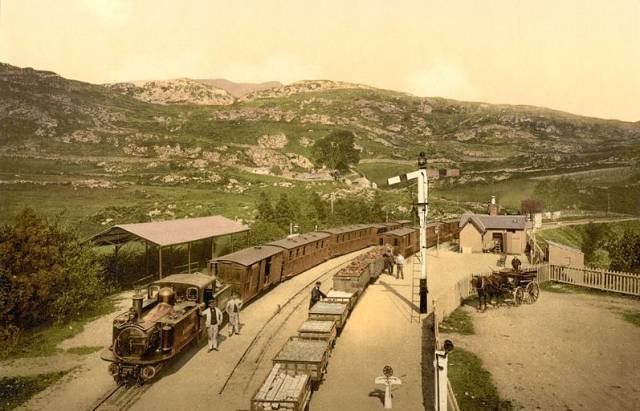Ffestiniog Railway
Horse and gravity operation
The line was constructed between 1833 and 1836 to transport slate from the quarries around the inland town of Blaenau Ffestiniog to the coastal town of Porthmadog, where it was loaded onto ships. The railway was graded so that loaded wagons could be run by gravity downhill all the way from Blaenau Ffestiniog to the port. The empty wagons were hauled back up by horses, which travelled down in special 'dandy' wagons. To achieve this continuous grade (about 1 in 80 for much of the way), the line followed natural contours and employs cuttings and embankments built of slate blocks without mortar. Prior to the completion in 1844 of a long tunnel through a spur in the Moelwyn Mountain, the slate trains were worked over the top via inclines (designed by Robert Stephenson) the site of which can still be seen.
Up to six trains daily were operated in each direction, and a printed timetable was published on September 16, 1856 by Charles Easton Spooner who, following his father, served as Manager and Clerk for 30 years. It shows departures from the "Quarry Terminus" (at that time Dinas Junction) at 7:30, 9:28, 11:16, 1:14, 3:12 and 5:10. Trains waited ten minutes at the intermediate stations called "Tunnel", "Hafod y Llyn" and "Rhiw Goch". The fastest journey time from Quarry Terminus to Boston Lodge was 1 hour 32 minutes, including three stops. From Boston Lodge the slate wagons were hauled to and from Porthmadog harbour by horses. Up trains took nearly six hours from Boston Lodge to the Quarry Terminus, and each train ran in up to four sections, each hauled by a horse and comprising eight empty slate wagons plus a horse dandy. This timetable gave a maximum annual capacity of 70,000 tons of dressed slate. Two brakesmen travelled on each down train, controlling the speed by the application of brakes as needed. At passing loops trains passed on the right and this continues to be a feature of Ffestiniog Railway operation.
There is evidence for tourist passengers being carried as early as 1850, without the blessing of the Board of Trade, but these journeys would also observe the timetable.
Steam and gravity operation
In October 1863 steam locomotives were introduced, to allow longer slate trains to be run, and this also enabled the official introduction of passenger trains in 1865: the Ffestiniog was the first narrow-gauge railway in Britain to carry passengers. In 1869 the line's first double Fairlie articulated locomotive was introduced, and these double-ended machines have since become one of the most widely recognised features of the railway.
Down trains continued to run entirely by gravity, but faster up journeys and longer trains increased line capacity. A new timetable dated October 1863 shows six departures daily from each terminus at two hour intervals, starting at 7:00 am and taking 1 hour 50 minutes including stops (totalling 20 minutes) at Tanygrisiau, Hafod-y-Llyn and Penrhyn. Trains passed only at Hafod-y-Llyn (from 1872 Tan-y-Bwlch). When passenger services started, the usual practice was for locomotive hauled up trains to consist of loaded general goods and mineral wagons, followed by passenger carriages, followed by empty slate wagons with brakesmen. Down trains were run in up to four separate (uncoupled) portions: loaded slate wagons, goods wagons, passenger carriages and finally the locomotive running light. This unusual and labour intensive method of operation was short lived and eventually the passenger and goods portions were combined into a single train headed by the locomotive.
The loaded slate trains continued to operate by gravity until the end of passenger services in 1939. Slate trains eventually became very long - trains of less than eighty slate wagons carried two brakesmen, but over eighty wagons (and this became common) required three brakesmen. About one wagon in every six was equipped with a brake, the others were unbraked. Trains continued to pass at Tan-y-Bwlch and to a lesser extent at Minffordd. The Summer timetable for 1900 had nine trains daily in each direction, and trains had been accelerated to one hour from Porthmadog to Duffws including stops at Minffordd, Penrhyn, Tan-y-Bwlch, Dduallt (request), Tanygrisiau, Blaenau (LNWR) and Blaenau (GWR). Speeds in excess of 40 mph were then normal.
The original passenger coaches (some of which still survive) were small four wheeled vehicles with a very low centre of gravity. In 1872 the FR introduced the first bogie carriages to operate in Britain, Nos. 15 and 16, which were also the first iron-framed bogie coaches in the world. The continuous vacuum brake was installed in 1893. The line was fully signalled with electric telegraph and staff and ticket working. Electric Train Staff instruments were introduced in 1912 and they continue in use to the present day.
Decline of slate and development of tourism
By the 1920s the demand for slate as a roofing material dropped owing to the advent of newer materials and to the loss of the overseas trade in World War I. As a result, the railway suffered a gradual decline in traffic.
In 1921 the Aluminium Corporation at Dolgarrog in the Conwy Valley bought for £40,000 a controlling interest in the FR and Henry Jack became Chairman, the FR company's financial administration moving to Dolgarrog. Jack was also chairman of the new Welsh Highland Railway and was instrumental in getting government backing for its completion on the understanding that the FR and the WHR would be jointly managed from Porthmadog, with maintenance undertaken at Boston Lodge and with other economies of scale. In 1923, the FR line was joined to the WHR line at a station called "Portmadoc New". The Welsh Highland line was almost totally dependent on tourism and this proved slow to develop.
To gain additional expertise in light railway operation which was being introduced on the FR and WHR to cut operating overheads, Colonel H. F. Stephens was in 1923 appointed part-time as Engineer to both companies. Stephens became Chairman and Managing Director of both companies in 1924. When the WHR was taken into receivership in 1927, Colonel Stephens was appointed as Receiver for the WHR and financial administration of both companies moved to Tonbridge in Kent. The fortunes of the WHR, despite great efforts, failed to improve and it became bankrupt in 1933. In order to protect their investments, the joint owners of both companies arranged for the WHR to be leased by the FR, but the WHR losses continued and it closed in 1937.
The FR continued to operate its slate traffic, a workmen's train on weekdays throughout the year and a summer tourist passenger service. Ordinary passenger services ceased on the FR on 15 September 1939, shortly after the outbreak of World War II. The workmen's passenger service ran for the last time on Saturday 16 September 1939. Slate trains were from then onwards operated three days each week, but gravity operation was discontinued. Slate traffic ceased on 1 August 1946, apart from the section from Duffws to the North Western yard through Blaenau Ffestiniog town centre, which was leased on 7 October 1946 to the quarry owners. This provided the railway company, which retained the services of a resident manager at Porthmadog, with a small income throughout the moribund years.
The original Act of Parliament which permitted the building of the line made no specific provision for its closure or abandonment. Although the main line had ceased functioning, the company could not dismantle the railway, so the track and infrastructure were left in place. Another Act of Parliament could have been sought to cancel the old one, but the Company did not have the money for such an action. However, without maintenance it soon became overgrown and unusable.
Restoration
From 1949, various groups of rail enthusiasts attempted to revitalise the railway. Eventually, on 24 June 1954 a group of volunteers funded by Alan Pegler purchased the company to run it as a tourist attraction, and gradually restored the line to working order. This was not helped by a decision by the Central Electricity Generating Board (CEGB) in 1954 to build the Ffestiniog Pumped Storage Scheme, including the Tanygrisiau reservoir (Llyn Ystradau), which flooded part of the northern end of the line. The Festiniog Railway Company was able to obtain compensation in 1972, after the second-longest legal battle in British legal history, having taken eighteen years and two months. Two years later, as a result of the case, the British Parliament passed the Land Compensation Act 1973.
On 18 August 1954, prior to commencing the restoration, in an inspection, the first of many, Colonel McMullen of the Ministry of Transport, Railways Inspectorate, accompanied by Alan Pegler, several directors and other supporters walked the line from Blaenau Ffestiniog to Porthmadog. The work of restoration began on 20 September 1954 when Morris Jones, the foreman fitter who had last worked for the railway in March 1947, rejoined the staff to complete the rebuilding of the locomotive 'Prince' on which he had been engaged when the works closed. He was joined at Boston Lodge works by two volunteers, Bill Harvey and Allan Garraway. 6 November 1954 marked the completion of sixty years service with the FR of Robert Evans (for almost 25 years as Manager) and a special train was run (with difficulty) from Minffordd to Porthmadog to celebrate the occasion and convey Mr Evans, his wife, Alan Pegler (Company Chairman) and guests en route to a clock presentation ceremony. Mr Evans continued in service as Manager until his retirement on 1 June 1955 when Allan Garraway was appointed as Manager.
The first public passenger train from Porthmadog to Boston Lodge ran on 23 July 1955. Prince returned to service on 3 August 1955 and, following extensive boiler repairs, Taliesin, then the latest of the FR Fairlie articulated engines, returned to service on 4 September 1956. The passenger service was extended to Minffordd on 19 May 1956, to Penrhyn on 5 June 1957 and to Tan-y-Bwlch on 5 April 1958. Increasing traffic was putting severe demands on the track - over seven miles had been reopened in four years. A long period of consolidation, rolling stock restoration and track renewal followed before the extension to Dduallt on 6 April 1968. Extension to Dduallt was celebrated on 28 May 1968 by the re-introduction of the Ffestiniog Railway Letter Service.
History
The railway company is properly known as the "Festiniog Railway Company", and this contemporary anglicised spelling is still the official title of the company as defined by the Act (2 William IV cap.xlviii) that created the railway. It is the oldest surviving railway company in the world (although not the oldest working - a record which goes to the Middleton Railway), having been founded by the Act of Parliament on 23 May 1832 with capital mostly raised in Dublin by Henry Archer, the company's first secretary and managing director. Most British railways were amalgamated into four large groups in 1921, and then into British Railways in 1948, but the Festiniog Railway Company, in common with most narrow gauge railways, remained independent: in 1921 this was due to political influence, whereas in 1947 it was left out of British Railways because it was closed for traffic despite vigorous local lobbying for it to be included.
Various important developments in the Railway's early history were celebrated by the firing of rock cannon at various points along the line. Cannon were fired, for instance, to mark the laying of the first stone at Creuau in 1832, the railway's opening in 1836, and the opening of the Moelwyn Tunnel in 1842. The passing of the Festiniog Railway Bill through Parliament also saw cannon celebrations, but on this occasion a fitter at Boston Lodge, who was assisting with firing, lost the fingers of one hand in an accident.
Festiniog Railway Time Line compiled by Peter Johnson
1832 | 23 May | Festiniog Railway Act, incorporation, construction and operation |
1836 | 20 April | Festiniog Railway opened for slate traffic, worked by gravity |
1838 | 27 July | Festiniog Railway Act, restructure |
1856 |
| Charles Easton Spooner appointed secretary and engineer; treasurer from 1847, he oversaw the FR’s technical development until his death in 1889. His father, James Spooner, had surveyed the line and overseen its construction. |
1863 |
| Steam locomotives introduced |
1864 | October | Captain Tyler inspected and approved for passengers, the first less-than standard gauge line to be approved. |
1865 | 6 January | Passenger service started |
1869 | 26 July | Festiniog Railway Act, double track and other purposes |
1869 |
| First double Fairlie, 0-4-4-0T Little Wonder, entered service |
1872 |
| First bogie carriages (Nos 15 and 16) put into service |
1879 |
| First locomotive, double Fairlie 0-4-4-0T Merddin Emrys,builtat Boston Lodge, LNWR opened to Blaenau Festiniog, FR decline started |
1898 | 23 May | Festiniog Railway (Deviation) Certificate made, authorising Dinas deviation |
1914-20 |
| Railway under government control |
1915 |
| Boston Lodge designated government shell factory |
1918 |
| Shell factory closed |
1921 |
| FR taken over by the Welsh Highland Railway promoters; operating loss made for the first time since 1842 |
1923 | 30 January | Festiniog Railway (Light Railway) Order made, authorising operation as a light railway, construction of the junction railways connecting with the Welsh Highland Railway and the new Portmadoc station to be used by both railways. Colonel H. F. Stephens appointed engineer of FR and WHR from 1 May, salary £100 plus expenses |
1924 | 24 June | Stephens’ resignation accepted; he had agreed to continue by 5 September and was elected a director on 29 October; appointed chairman and managing director on 16 December, salary £200 |
1930 |
| Passenger service became seasonal, for the benefit of tourists |
1931 |
| Stephen’s resignation as chairman accepted on 30 April, died on 24 October |
1939 | 15 September | Passenger services ended |
1946 | 1 August | Goods service ended |
1954 | 22 June | Control acquired by Alan Pegler supported by FR Society |
1955 | 23 July | Services resumed between Portmadoc and Boston Lodge (1 mile) |
1956 | 19 May | Services resumed to Minffordd (2 miles) |
1957 | 20 April | Services resumed to Penrhyn (3 miles) |
1958 | 4 April | Services resumed to Tan y Bwlch (7½ miles) |
1964 | 2 January | First sod of 2½ mile deviation dug |
1968 | 6 April | Services resumed to Dduallt (9½ miles) |
1968 | 9 February | Festiniog Railway (Light Railway)(Amendment) Order made, Dduallt – Brookes Quarry deviation |
1975 | 17 June | Festiniog Railway (Light Railway)(Amendment) Order made, deviation on the west side of the reservoir |
1977 | 8 July | Deviation opened to Llyn Ystradau (temporary station, 11½ miles) |
1978 | 24 June | Deviation completed, services resumed to Tanygrisiau (12 miles) |
1979 |
| Third double Fairlie, 0-4-4-0T Earl of Merioneth, completed at Boston Lodge |
1981 | 20 January | Blaenau Ffestiniog (Central Station) Light Railway Order made |
1982 | 25 May | Services resumed to Blaenau Ffestiniog (13½ miles) |
1982 | 13 October | Festiniog Railway Light Railway (Amendment) Order made, Glan y pwll and Stwlan dam level crossings |
2011 | 20 April | 175th anniversary of opening commemorated |

